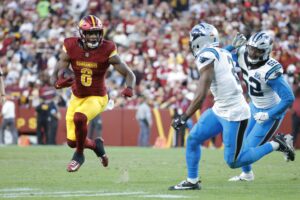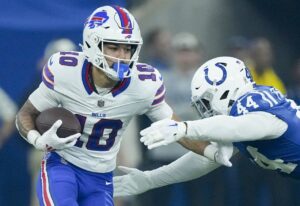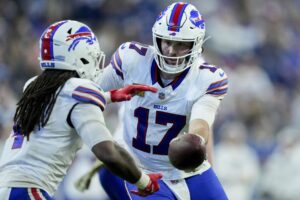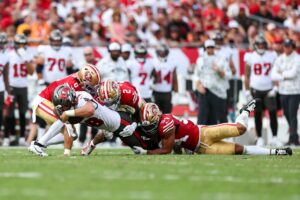The New York Giants revamped their offense this offseason. Featuring Kenny Golladay, the new-look Giants receiving core is turning heads. But there hasn’t been as much buzz about how John Ross fits in.
In free agency, the former Cincinnati Bengals receiver signed with New York on a one-year, $2.5 million deal. Ross likely agreed to the short-term deal to give himself a new opportunity to thrive on the field and earn a multi-year deal next offseason. With a deep wide receiver depth chart, it’s intriguing to consider how John Ross fits in the Giants offense.
How will the New York Giants Offense Use John Ross?
Career Overview
As the ninth overall pick in the 2017 NFL Draft, Ross was expected to develop into an unstoppable deep threat. He showcased his elite speed at his NFL Combine with a 4.22 40-yard dash, but Ross hasn’t taken full advantage of his quickness in the NFL. In four seasons, Ross only played in 27 out of a possible 72 games due to numerous injuries. Those issues convinced the Bengals to decline Ross’s fifth-year option in 2020, which set him up to become a free agent this offseason. His relationship with the team only soured from there, ultimately leading to a trade request and benching last year.
When Ross did see the field, Cincinnati primarily used him as a deep threat, which isn’t surprising. What’s unique, though, is that he attacked coverages from everywhere on the line of scrimmage. Many deep threats under 6 feet tall — Ross is 5’10” — tend to mostly make plays out of the slot. But a glance at Ross’s tape highlights his potential versatility.
A Fresh Start in New York
Ross will have to showcase that versatility to earn snaps and move up the Giants depth chart. New York has plenty of smaller “Z” receivers who can burn secondaries for big plays. Kadarius Toney, Darius Slayton, and Sterling Shepard have played those roles and are slated to play more snaps than Ross. So Ross will either need to offer a unique skillset or lighten the load for the rest of the receiving core.
He could fill a role that’s somewhat of a hybrid between the ones Shepard and Dante Pettis played last year. Pettis was a consistent mid-level target for Daniel Jones, working from both the slot and the outside. While Ross will likely compete with Pettis for snaps in training camp, he can definitely use his quickness to beat out Pettis and become a steady third-down option. As long as he can improve his route-running, Ross can develop into a dangerous weapon in offensive coordinator Jason Garrett’s intermediate passing concepts.
Ross could also take a bit of a burden off Shepard in the run game. In 2020, Garrett called many end-around plays for Shepard. These play calls often worked, but they might’ve kept Shepard from wreaking more havoc in the slot since they brought him increased attention from defenses. If the Giants can get Ross going on designed runs, they could force defenses to shift towards defending the run when he enters the huddle. That could leave the secondary vulnerable to deep shots down the field, which is what Ross is best at. If Shepard can thrive in these sets, imagine what an even faster receiver like Ross can do.
Sterling Shepard end around TD
Giants get on the board
(via @NFL)pic.twitter.com/4Ey9TNTAkB
— B/R Gridiron (@brgridiron) January 3, 2021
As previously mentioned, Ross’s deal with the Giants is a “prove-it” one. He won’t see the field enough to earn the market-setting contract that everyone originally expected four years ago. But if Ross can finally stay healthy and become a more versatile player, he could find a home in the Meadowlands.
Main photo:
Embed from Getty Images






